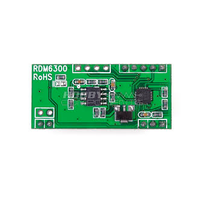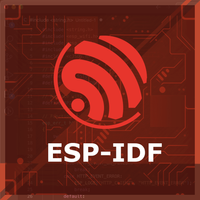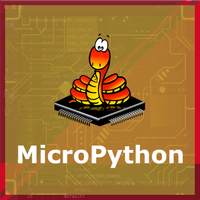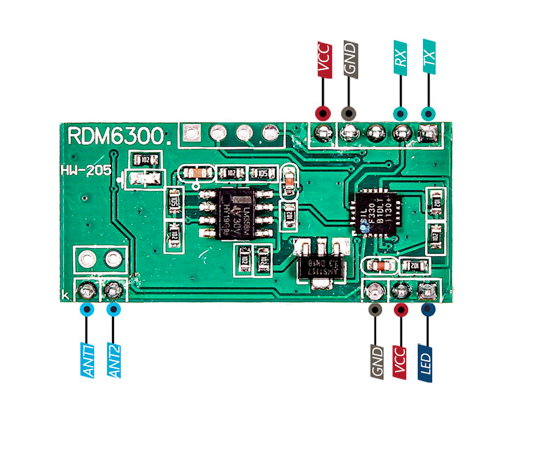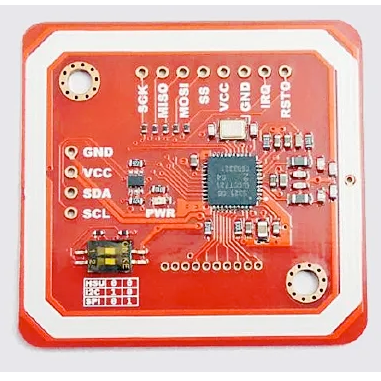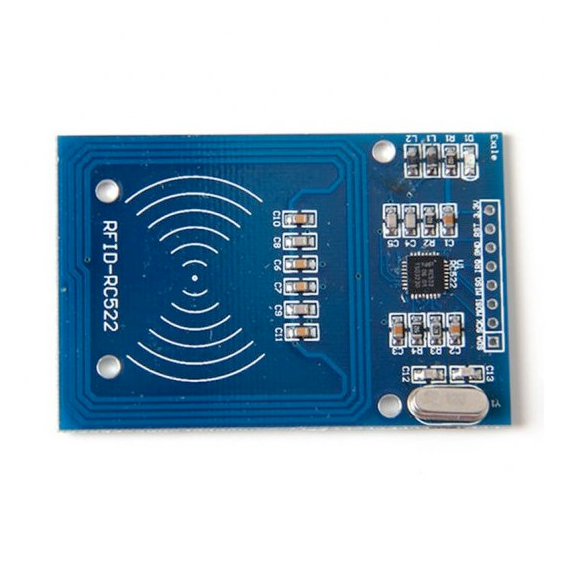ESP32 RDM6300 RFID Reader Module
Overview
The RDM6300 is a simple and reliable 125kHz RFID reader module suitable for a wide range of identification and access control applications. Its straightforward UART interface ensures easy integration into any project requiring RFID capabilities.
About RDM6300 RFID Reader Module
The RDM6300 is a compact and efficient RFID reader module designed for 125kHz RFID tags. Using a UART interface, it seamlessly integrates with ESP32, Arduino, and other microcontrollers, making it ideal for access control, inventory management, and identification systems.
⚡ Key Features
- 125kHz RFID Compatibility – Reads low-frequency (LF) RFID tags.
- UART Communication – Simple integration with microcontrollers via serial output.
- Compact & Low Power – Ideal for battery-powered and embedded applications.
- Secure Identification – Transmits unique tag IDs for authentication purposes.
With its ease of use and reliable performance, the RDM6300 is a great choice for RFID-based security and tracking applications. 🚀
Where to Buy



Prices are subject to change. We earn from qualifying purchases as an Amazon Associate.
Technical Specifications
Pinout Configuration
The VCC pin is used to supply power to the sensor, and it typically requires 3.3V or 5V (refer to the datasheet for specific voltage requirements). The GND pin is the ground connection and must be connected to the ground of your ESP32.
The RDM6300 pinout includes:
- VCC: Power supply input (3.3V to 5V).
- GND: Ground connection.
- TX: UART transmit data (connects to microcontroller RX).
- RX: UART receive data (not commonly used).
Wiring with ESP32
Troubleshooting Guide
Common Issues
❌ Module Fails to Power On
Issue: The RDM6300 module does not power up or respond to commands.
Possible causes include insufficient power supply, incorrect wiring, or faulty hardware.
Solution: Ensure the module is connected to a stable power source within the recommended voltage range of 5V. Verify that all connections are secure and correctly configured. If the problem persists, consider testing the module with a different power source or replacing it.
🔌 Communication Interface Not Working
Issue: The module fails to communicate with the microcontroller over the chosen interface (typically UART).
Possible causes include incorrect wiring, improper interface selection, or incompatible voltage levels.
Solution: Double-check the wiring to ensure correct connections for UART communication. For UART, verify the TX and RX lines are properly connected. Ensure that the microcontroller's UART interface is enabled and configured correctly.
🚫 Unable to Read Tags
Issue: The module initializes correctly but fails to read RFID tags.
Possible causes include incorrect antenna orientation, insufficient power supply, or interference from nearby electronic devices.
Solution: Ensure the module's antenna is properly oriented and positioned near the tags. Verify that the power supply provides adequate current for the module's operation. Keep the module away from sources of electromagnetic interference.
⚠️ Inconsistent Tag Detection
Issue: The module detects tags intermittently or with delays.
Possible causes include low-quality tags, environmental interference, or firmware issues.
Solution: Test with different tags to rule out tag quality issues. Ensure the operating environment is free from strong electromagnetic interference. Update the module's firmware to the latest version to benefit from bug fixes and improvements.
💻 Library or Software Issues
Issue: The module operates erratically or produces errors during operation.
Possible causes include outdated or incompatible libraries, incorrect initialization, or software bugs.
Solution: Ensure that the latest version of the RDM6300 library is installed and compatible with your development environment. Review the initialization code to confirm that the module is set up correctly. Consult the module's documentation and community forums for guidance on proper usage.
Debugging Tips
🔍 Serial Monitor
Use the Serial Monitor to check for error messages and verify the sensor's output. Add debug prints in your code to track the sensor's state.
⚡ Voltage Checks
Use a multimeter to verify voltage levels and check for continuity in your connections. Ensure the power supply is stable and within the sensor's requirements.
Additional Resources
Code Examples
Arduino Example
#include <SoftwareSerial.h>
#define RX_PIN 10
#define TX_PIN 11
SoftwareSerial rfid(RX_PIN, TX_PIN);
void setup() {
Serial.begin(115200);
rfid.begin(9600);
Serial.println("RDM6300 initialized. Waiting for RFID tags...");
}
void loop() {
if (rfid.available() > 0) {
String tag = "";
while (rfid.available() > 0) {
char c = rfid.read();
tag += c;
}
Serial.print("Tag detected: ");
Serial.println(tag);
}
delay(500);
}setup function initializes the UART communication, and the loop reads incoming tag data and prints it to the Serial Monitor. The code captures the entire tag UID transmitted by the module and displays it for further use.ESP-IDF Example
#include <stdio.h>
#include "driver/uart.h"
#include "freertos/task.h"
#define RX_PIN 16
#define TX_PIN 17
#define UART_PORT UART_NUM_1
void init_uart() {
uart_config_t uart_config = {
.baud_rate = 9600,
.data_bits = UART_DATA_8_BITS,
.parity = UART_PARITY_DISABLE,
.stop_bits = UART_STOP_BITS_1,
.flow_ctrl = UART_HW_FLOWCTRL_DISABLE
};
uart_param_config(UART_PORT, &uart_config);
uart_set_pin(UART_PORT, TX_PIN, RX_PIN, UART_PIN_NO_CHANGE, UART_PIN_NO_CHANGE);
uart_driver_install(UART_PORT, 1024, 0, 0, NULL, 0);
}
void app_main() {
init_uart();
printf("RDM6300 initialized. Waiting for tags...\n");
while (true) {
char data[128];
int len = uart_read_bytes(UART_PORT, data, sizeof(data) - 1, 100 / portTICK_PERIOD_MS);
if (len > 0) {
data[len] = '\0';
printf("Tag detected: %s\n", data);
}
vTaskDelay(pdMS_TO_TICKS(500));
}
}init_uart function initializes the UART peripheral, and the app_main function continuously reads incoming tag data. The tag UID is logged to the console, making it suitable for integration into access control or identification systems.ESPHome Example
uart:
tx_pin: GPIO17
rx_pin: GPIO16
baud_rate: 9600
sensor:
- platform: custom
lambda: |-
return {nullptr};
sensors:
- name: "RFID Tag UID"
binary_sensor:
- platform: template
name: "Tag Detected"PlatformIO Example
platformio.ini
[env:rdm6300]
platform = espressif32
board = esp32dev
framework = arduino
monitor_speed = 115200PlatformIO Example Code
#include <HardwareSerial.h>
HardwareSerial rfid(1);
void setup() {
Serial.begin(115200);
rfid.begin(9600, SERIAL_8N1, 16, 17); // RX, TX
Serial.println("RDM6300 initialized. Waiting for tags...");
}
void loop() {
if (rfid.available() > 0) {
String tag = "";
while (rfid.available() > 0) {
char c = rfid.read();
tag += c;
}
Serial.print("Tag detected: ");
Serial.println(tag);
}
delay(500);
}loop function continuously checks for tag data and handles its output, making it suitable for quick prototyping or integration into other systems.MicroPython Example
from machine import UART, Pin
import time
# Initialize UART
uart = UART(2, baudrate=9600, tx=17, rx=16)
print("RDM6300 initialized. Waiting for tags...")
while True:
if uart.any():
tag = uart.read().decode('utf-8')
print("Tag detected:", tag)
time.sleep(0.5)Conclusion
The ESP32 RDM6300 RFID Reader Module is a powerful NFC sensor that offers excellent performance and reliability. With support for multiple development platforms including Arduino, ESP-IDF, ESPHome, PlatformIO, and MicroPython, it's a versatile choice for your IoT projects.
For optimal performance, ensure proper wiring and follow the recommended configuration for your chosen development platform.
Always verify power supply requirements and pin connections before powering up your project to avoid potential damage.
